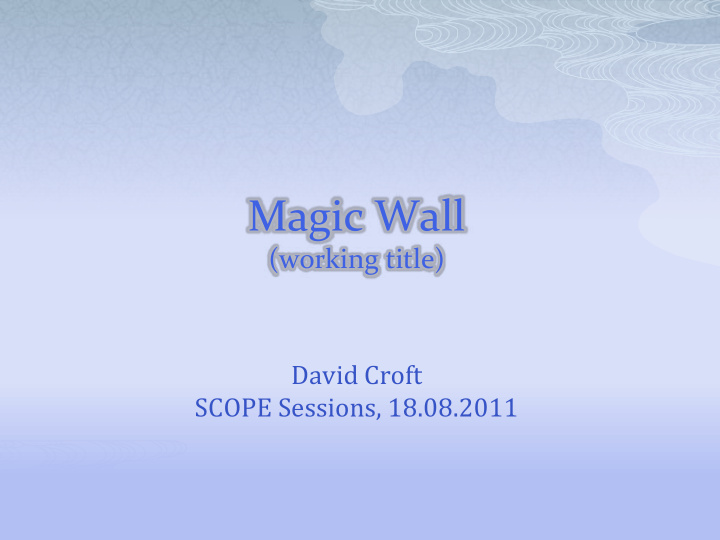



Magic Wall (working title) David Croft SCOPE Sessions, 18.08.2011
Magic Wall THE PRINCIPLE
Electromagnetic Spectrum
Human Eye Model
Magic Wall THE HARDWARE
It’s not a Kinect (Damnit) Has built in IR laser projector Only outline needed, not depth Minimum range 1.2m, maximum range 3.5m Intrusive Proprietary connector 640×480 @ 30fps (only) Most functionality is within the Xbox Expensive (100 € +)
Inaccurate even at short range
Camera Cheap Fast frame rate Good resolution “ Hackable ” – to remove IR-blocking filter and add IR band-pass filter Cross-platform drivers
PlayStation Eye Camera 640x480 @ 60fps (320x240 @ 120fps) Free community-written drivers for Windows, Mac, Linux (from 2.6.29) Already in use for open source multi-touch tables IR hacking well documented Very cheap for its quality (15 € )
Hacking the PS3 Eye Get it open (hard!) Remove built-in IR-blocking filter Fully-exposed and developed camera film, or floppy disk, work OK as visible light filter Better: specialised IR band-pass filter Get it closed without smashing the CCD sensor (even harder!)
IR Bandpass Filter
Infrared Emission Filtered incandescent lamps “IR” heat lamps (but also heat and light, and expensive) Lasers LEDs
Infrared floodlight Contrast between wall and ambient IR requires powerful emitters Position behind viewers requires unusual angle Should scale well to larger areas Still looking for a good source
What wavelength? 850-875nm seems best with the cameras I tested Also the cheapest Minor visible red glow, but only if you look at the LEDs Filter will depend on this too
850nm Bleeds slightly into visible spectrum Doesn’t seem visible on reflection – but need to test with a child!
Magic Wall THE SOFTWARE
Requirements OpenCV (Open Computer Vision) library Much useful but cryptic real-time computer vision functionality Processing Simplified programming environment for visual artists My library Wraps all of the above. Will be released soon at www.davidc.net
Software Flow
Source
Source
Source Controls
Calibration
3D Calibration Camera and projector are not at the exact same position Lenses and FOV are different anyway Need to recalibrate so that the final projected image lines up with bodies
3D Calibration Similar principle to touchscreen calibration, but in 3D space Correlate points in both projector and camera space Naïve implementation ignores perspective, but is fast and sufficient for not OpenCV has calibration routines
Calibration – Source Image
Calibration – Control Points
Calibration - Output
Calibration Method Turn off floodlights IR LED on a stick Search for a single blob of a given size range Take the average of its centre of gravity over a period of time Repeat for other points Run calibration routine Then re-project each source frame
Calibration Markers
Calibration
Calibration Controls
Blur
Threshold
Blur and Threshold Controls
Classification
Blob Detection
Blob Filtering
Contour Approximation
Blob Detection Controls
Blob Tracking
Scene
Display Controls
Montage
Scene Controls
Example Scenes Spotlight Glow Image projection Shadow trail Flames
Example Scenes Video projection Insects/flocking Rain Beach ball game Forest
Example Scenes Develop a reference hardware design Finish and release software as open source Invite others to develop scenes
Next Steps Find better floodlights Improve, finish and optimise software Write more demos Turn it into a Processing library Release it as open source software with a hardware reference design Regions of interest Camera and projector tiling
Further information Documentation will appear over the next few weeks at www.davidc.net david@davidc.net
Recommend
More recommend